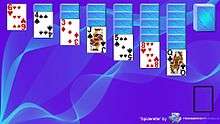Spider (solitaire)
Spider is a type of patience game. It is one of the more popular two-deck solitaire games. The game's name comes from a spider's eight legs, referencing the eight foundation piles that must be filled to win the game.[1]
| A Patience game | |
.jpg) One initial layout in the game of Spider | |
| Named variants | Gigantic Spider, Relaxed Spider, Spiderette, Spiderwort, Will o' the Wisp |
|---|---|
| Family | Spider |
| Deck | Double 52-card |
| See also Glossary of solitaire | |
Game
The main purpose of the game is to remove all cards from the table, assembling them in the tableau before removing them. Initially, 54 cards are dealt to the tableau in ten piles, face down except for the top cards. The tableau piles build down by rank, and in-suit sequences can be moved together. The 50 remaining cards can be dealt to the tableau ten at a time when none of the piles are empty.
Layouts
- Spider Layout:
- Played with 2 decks.
- The Tableau consists of 10 stacks with 6 cards in the first 4 stacks, with the 6th card face up. And 5 cards in the remaining 6 stacks, with the 5th card face up.
- A deck that deals out one card to each stack.

- Spiderette Layout:
- Played with 1 deck.
- Klondike like Tableau. The Tableau consists of 7 stacks ranging from 1 card to 7 cards in each stack.
- Spider like deck. The deck deals out one card to each stack.
Variants

- Spider 2 Suit: Same as classic Spider solitaire, except this game is played with only 2 suits instead of 4, usually Spades and Hearts.
- Spider 1 Suit: Same as classic Spider solitaire, except this game is played with only 1 suit instead of 4, usually Spades.
- Gigantic Spider: Four decks
- Relaxed Spider: Does not require all spaces to be filled before redealing
- Spiderette: Only one pack, Klondike layout; see above
- Spiderwort: Three decks
- Will o' the Wisp is another solitaire card game which was invented by Geoffrey Mott-Smith and is played the same way as Spiderette. The exception is that on the onset, twenty-one cards are dealt into seven columns of three with only the top card of each column face-up.
- Simple Simon is another common one-deck variant of Spider.
- Mrs. Mop is a Spider relative in which all the cards are dealt face-up.
Software implementations
Common software versions of Spider are included with versions of Microsoft Windows 7, Vista, ME and XP as Spider Solitaire. Spider Solitaire was introduced in the Microsoft Plus! 98 addition pack for Windows 98.[2] The game comes in three versions: Easy or Beginner (with 8 Spade packs), Medium or Intermediate (with four packs each of Spades and Hearts), and Hard or Advanced (with two each of all four suits).
An earlier version was written for Windows 3.x in 1991 by John A. Junod, the original developer of WS_FTP. The final version was Windows Spider Solitaire version 92.01.04. He also wrote a DOS version called EGA-Spider with version up to 93.07.05. A similar game called Arachnid, was also written for Windows 3.x in 1991 by Ian Heath, a computer science professor at the University of Southampton in the UK. The latest known version is 1.2 and is quite well polished. This game was also re-written for 32-bit operating systems and is referred to as Arachnid 32.
On Unix operating systems, an early version was developed around 1989 at Sun Microsystems. A version of Spider Solitaire typically comes bundled with both the KDE and GNOME desktop environments on other Unix-like operating systems such as Linux and BSD, under the names KPatience and AisleRiot Solitaire, respectively. Versions for Macintosh and most other operating systems are also available.
The newer Windows versions offer three levels of difficulty, with one, two, or four suits. These play modes are equivalent to disregarding suit difference, either within the colors or altogether, and thus can be simulated in the physical card game, though the computer version aids visibility by representing all cards as spades and/or hearts.
Scoring
Different software implementations of spider offer alternative scoring rules. The version from Sun Microsystems from 1989 defines the following rules in the manual: 10 points for each initially face down card that gets turned over; 15 additional points for each column where all the face-down cards have been turned over (even if you don't manage to get a space); 2 points for each card that is sitting atop the next higher card of the same suit; 50 points for each completed suit removed from the tableau (in which case you do not also score for the 12 cards sitting atop next higher cards). This yields a maximum score of 990. If you win the game with 4 or more completed suits still in the tableau, add 2 points for each suit after the first three. Thus winning with all eight suits still in the tableau yields a score of 1000.
In the Windows versions of Spider Solitaire, the scoring is calculated with a starting score of 500. One point is subtracted for each move (including any use of an undo); 100 points are added for each suit completed. This allows for a theoretical maximum score of 1254.
See also
- Solitaire terminology
- List of solitaires
References
- "Spider Solitaire". Solitaired. Unwind Media. Retrieved 29 July 2020.
- "Consumer Companion for Windows 98 Offers Powerful New Utilities Desktop Themes and Exciting Games" (Press release). Microsoft Corporation. 25 June 1998. Retrieved 12 October 2010.
- "Spider Solitaire – Card Game Rules." Bicycle Playing Cards. The United States Playing Card Company, n.d. Web. 13 Sept. 2016.
External links
- Winnable Spider Solitaire Games – a study on the winnability of Spider solitaire games
